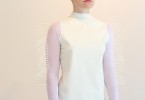A new, highly conceptual line of wearables from the designer Neri Oxman explores the replication of life-sustaining bodily functions in vibrant colors and shapes, employing synthetic microorganisms to do the work of the digestive, nervous, skeletal and integumentary (skin and its appendages) systems.
Conceptual imagery of the Zuhal. Photo source: Neri Oxman
Each of the four articles in the line resembles the specific bodily system it seeks to reproduce. “You’re designing a 3D printed template which defines what type of biological functionality can take place in which location within the wearable,” said Oxman, explaining the concept behind each look in an interview with FastCoDesign. “The design then becomes not only a wearable microbial factory, but also literally a second skin that can mediate between the external environment and the inner body.”
The Mushtari. Photo source: Neri Oxman
One member of the line, for example, represents the digestive tract. Dubbed Mushtari, it comprises a single strand of 3D printed acrylic resin coiled into a series of intestine-like tubes, painted in red and blue tones. Inside it are cyanobacteria and E. Coli that use light to create sucrose through photosynthesis. The sucrose is edible. Another wearable can craft calcium for strong bones, while another puts out fluorescent photons that offer a light source in dark environments.
Conceptual imagery of the Otaared exoskeleton. Photo source: Neri Oxman
The current line is only the beginning for Oxman, who, along with the team at MIT assisting her with the designs, wants to take things a step further by developing 3D printed valves capable of transporting fluid, along with membranes that separate food and fuel.
For more information, see the full article here.





